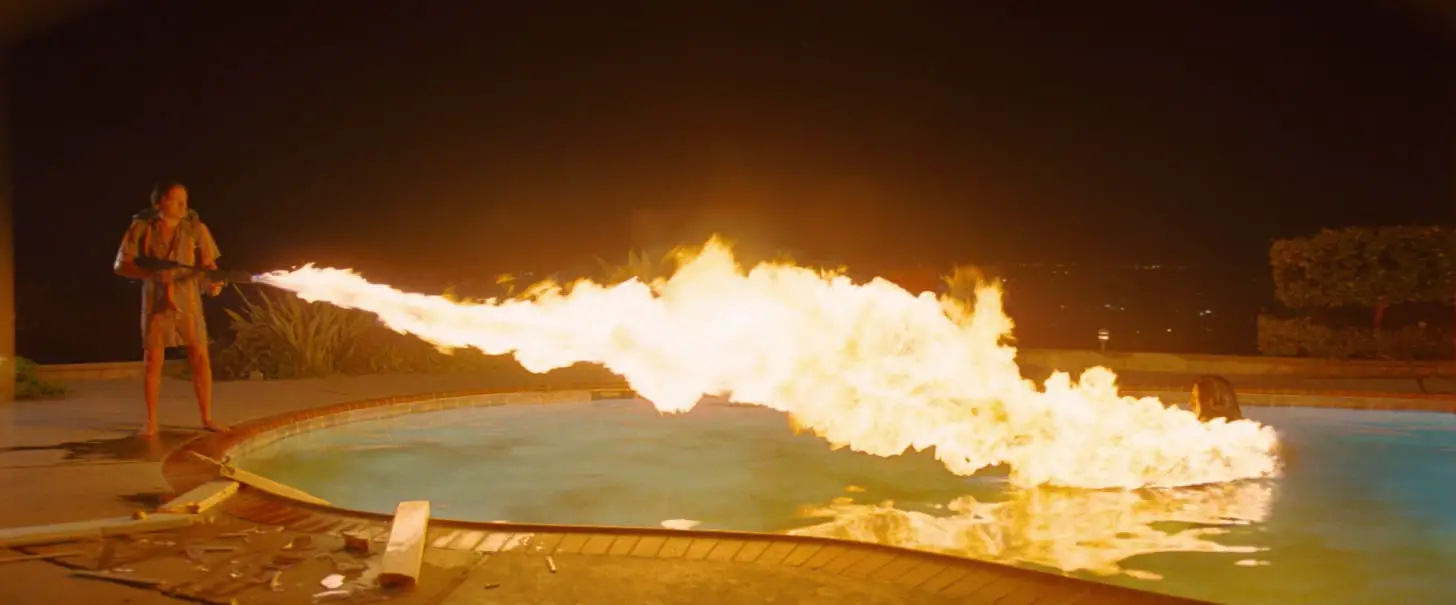Apoliticism is the effort, conscious or unconscious, to drain symbols and arguments of their inherent political content and context. In the many debates that have dogged Quentin Tarantino about violence in his films, he has maintained a consistent stance that the violence in his film is untainted by ideology. He is the ultimate embodiment of entertainment for entertainment’s sake and has made some of the most consistently entertaining films of recent decades: the definitive pulp film maker. However, in his reappropriation of elements of pop culture, he has drawn from a variety of influences, many of which were highly political in nature and often suspect. Even if we accept that his work is apolitical in intent, adopting a political text and draining it of its meaning is a political act of erasure. Therefore, there remains in his work a plenitude of artifacts of these original texts that merit discussion and may prove enlightening of the nature of the position Tarantino’s films hold in modern culture. Through his adoption of pop culture ephemera, Quentin Tarantino routinely appropriates deeply political texts and symbols, with often uncritical and careless results.
First we may have to deal with the question of cultural appropriation as a whole. Tarantino is a white man who has come under fire for his liberal appropriation of Black and East Asian culture as routinely as he has the unapologetically gratuitous violence of his films. This combination of ethnic and cultural influences is a common facet of postmodern pop culture and an integral part of the American identity. Tarantino’s routine focus on white protagonists enjoying Black and Asian worlds, allows white viewers an experience of “cool” they would otherwise be unable to access. Unable that is, without identification with a Black or Asian character, a negotiation they are not forced to navigate thanks to Tarantino’s white-centric casting.
Tarantino has of course, routinely centred his films upon non-white protagonists, often played by Samuel L. Jackson, whose presence has legitimated Tarantino’s appropriation of Black culture for decades. Centring his films upon Black icons like Jackson, Jamie Foxx and Pam Grier, allows Tarantino to pay more respectful and legitimate homage to Black culture. He has remade Blaxploitation cinema in the 21st Century, but his lens has to varying extents remained paternalistically white. The catharsis offered by his historical films like Inglorious Basterds, Django Unchained and Once Upon a Time…In Hollywood, is to pay escapist recompense to historical wrongs, allowing Jewish characters to fictionally avenge the holocaust, Black characters to fictionally avenge slavery, and perhaps most interestingly and personally, white Hollywood to avenge the Manson murders.
Django Unchained was of course, as the name implies, Tarantino’s homage to the Django spaghetti westerns of Sergio Corbucci. Tarantino’s fondest touchstones from cinema’s past come from the serialised adventures of iconic figures, something that through their shared influence, both Japanese samurai adventures like Zatoichi, Lady Snowblood and Lone Wolf and Cub and Spaghetti westerns like Django and most famously of all The Man with No Name developed throughout the ’60s and ’70s. Films like Django Unchained and Kill Bill resurrect these figures in the 21st Century. However, though these films were by and large, the same pulp fare Tarantino now makes, with any subversive politicism they exhibited being largely inadvertent, or a product of exhilaratingly shattering societal taboos, they were not uniform in this.
The Hateful Eight—in my view the best of Tarantino’s post Kill Bill works—Tarantino drew heavy inspiration from Sergio Corbucci’s 1968 masterpiece The Great Silence, a fiercely pessimistic anti-authoritarian polemic seeking to remove the halo adorning the bounty hunter figure immortalised through the other Sergio—Leone’s—films. Through the character of Klaus Kinski’s Loco, The Great Silence portrays bounty hunters as nothing less than opportunistic sadistic lackeys of the authorities, preying on those whom society has stripped of their rights for financial gain. It’s an Italian Bonnie and Clyde where the outlaws are the tragic heroes turning their backs on an indifferent and brutal society, and those hunting them are cruel, mechanical instruments of a callous hierarchical regime violently stamping out dissent among the lower orders.

Loco meets his nemesis in “silence”, a mute outlaw gunslinger portrayed by Jean-Louis Triginant, with whom he shares a carriage into the remote mountain town which plays theatre to the bloodshed to follow. Also along on this fateful ride is the well meaning but ineffectual local Sheriff Burnett (an unusually high profile role for a great Italian character actor in Frank Wolff). Evidently, what struck Tarantino about The Great Silence was not its virulently leftist politics or moral outrage, but the striking wintry backdrops and the storytelling potential of that carriage ride, which he expanded into the first act of his own blizzard bound western.
The Hateful Eight opens with its antihero bounty hunter protagonist Major Marquis Warren (Samuel L Jackson) stopping a carriage as it rides like hell to beat the blizzard hot on its heels. Just as Loco did in his carriage ride, Warren has two bodies with him, bodies worth money and to which he subjects the indignity in death of being strapped to the roof of the carriage, in order to bring them to town and collect his reward for having killed them. While in The Great Silence this scene elicits a debate between Loco and the Sheriff about the ethics of transporting what were once men in such a fashion, establishing it’s characters, conflict and theme: a callous and cruel bounty hunter and a moralistic sheriff more concerned with treating bodies with respect than the fact Loco has evidently just committed what amounts to a double homicide. Sheriff Burnett’s position allows him to exercise control over how bodies are transported, but incapable of stopping them piling up, much as he might like to. The contrast between him and Loco as two rival agents of the authorities is intensely political. Loco is doing precisely what the authorities want him to do, killing off a few troublemakers, and Burnett his hopelessly outmatched by such indifference to the sanctity of human life.
In The Hateful Eight however, the focus of this scene is centred wholly around trust. The carriage’s original occupants are another bounty hunter, the fiercely principled John Ruth (Kurt Russell) and his prisoner Daisy Domergue (Jennifer Jason Leigh), whom Ruth is determined to bring to town to stand trial. With its second half effectively a period-set murder mystery, The Hateful Eight unfolds as a series of pseudo-trial scenes, where the veracity of each character’s story is evaluated. Ruth suspects Warren of being an agent of Domergue’s gang out to spring her from capture, or else just an unscrupulous rival out to steal her bounty. The scene plays out as an interrogation of their personal motives. Through its investigative content, The Hateful Eight does somewhat play out as an exploration of the nature of justice and judicial process. Out of pure pragmatic practicality, Warren favors the “Dead” in Dead or Alive, while Ruth’s principles demand Domergue should die according to the ideal interpretation of the law, a stance that has earned him the nickname of “The Hangman”.
Later in the carriage ride, they are joined by Sheriff Chris Mannix (Walton Goggins) a former confederate soldier and vicious racist who takes immediate exception to sharing a carriage with Warren, but whose impoverished station—his mount has broken its ankle and that blizzard is incoming—forces him not to be fussy. Mannix’s racism aligns him with the equally bigoted Domergue, with lawman and outlaw momentarily aligned for reasons of pure prejudice. Mannix’s arrival therefore puts Ruth and Warren into an uneasy coalition, the division being along grounds of race and personal prejudice. Once the quartet arrive at their overnight lodgings at Minnie’s Haberdashery, Ruth conducts a similar interrogation of everyone there, all more or less equally suspect in his eyes.

Among these figures is another, more literal hangman: Oswaldo Mobray (Tim Roth, doing his best Christoph Waltz impression), who delivers a line that might well be taken for the thesis statement of the film:
The man who pulls the lever that breaks your neck will be a dispassionate man. And that dispassion is the very essence of justice. For justice delivered without dispassion is always in danger of not being justice.
This conflict, between passionate and dispassionate punishment is the purpose of the many pseudo-trials and interrogations throughout The Hateful Eight. Our antiheroes are trying to acquire sufficient knowledge of the situation to determine without prejudice who deserves to die and who doesn’t. This is antithetical to the original meaning of The Great Silence, which is broadly a compassionate film that argues no one deserves to die, least of all the outlaws whose crimes are motivated by necessity, necessity created by the indifference of those in power who are now condemning them to die.
With both Warren and Ruth conducting their assessments of each of their companions, Ruth plays judge and jury while Warren wastes little time demonstrating his willingness to also play executioner. Tarantino here borrows another trick from The Great Silence. The outlaw Silence’s modus operandi for killing bounty hunters with impunity is to always wait until they make the first aggressive move. He knows he’s a faster draw than any of them, so he can always plead self-defence when there’s witnesses to testify that his attacker drew first. One of those present at Minnie’s is another racist confederate General Sandy Smithers (Bruce Dern), who Warren decides to kill. He hands him a gun and tells him a story – possibly true but quite conceivably made up on the spot – of when Smither’s son came to kill him. Warren apparently turned the tables on Smithers Jnr. and just as he finishes telling Smithers Snr. how he raped his son, the general can hold back no longer and reaches for the gun. Warren promptly shoots him dead, confident of his immunity. Despite Warren’s open hostility and antagonism, the general drew first in front of witnesses.
You only need to hang mean bastards, but mean bastards you need to hang
At the very least, The Hateful Eight endorses capital punishment, however flippantly. Ruth and Warren are no saints, they number among the titular eight, but these characters are separated by degrees of hatefulness. One of the most entertaining tools in a storyteller’s kit is to shift allegiances between characters. As a formerly loathsome character loses something precious to them or is pitted against an even more vile antagonist, it can be an opportunity to reveal in them a potential for unexpected nuance and nobility. We see this in Sheriff Mannix, who we are immediately prejudiced against for his stupidity and bigotry, but who we slowly come to see in a more textured light through his wounding in a shootout and surprising coalition with Warren, the film ending on a note of bonding between the two of them as fellow officers of the law, bathing in the satisfaction of at last having done their duty.
Irreverence is regarded as a shield against ideological criticism and Tarantino is by no means alone in using it as such. Of course, the licensed jester is a valued role in society and should continue to be indulged for the sake of entertainment, but indulgence is not equal to immunity from criticism and we should ask why things are popular and what it is about them that appeals to us. Violence in not inherently political and depiction of it can have a variety of political applications, positive and negative. However primal and visceral a narrative is, all stories impart a perspective and worldview. Their agenda may be so deeply ingrained in our own core beliefs that we don’t even notice it, but even a simple battle between good and evil is going to include a wealth of definitions of what constitutes “good” and what constitutes “evil”, preconceived notions integral to an understanding of and engagement with the story. Icons of good and evil are thereby created within the story, and the traits those icons exhibit imparts a political ideology.
Some of these traits may be quite universally acceptable, strength, innocence and charity are good, cruelty, waste and ignorance are bad. Others are more contested though and begin to illustrate an ideological split; traditionalism, beauty, progressivism, conservationism, individualism, decisiveness, diplomacy, these all suggest different things that could be regarded as good or bad depending upon how they’re exercised, and that’s without getting into more specific debates like individual freedoms, sexual liberation, cultural preservation, financial independence, nationhood and so on. Even those universal tenets are open to debate. What is strength precisely? How is it defined and how is it exercised? Does the lauding and celebration of strength by implication vilify and condemn weakness? How does that apply when considering issues like disability and illness? If we’re proud of our strength and self-reliance should we be ashamed of our weakness and dependence? Should we deny such traits in ourselves and shun them others? And what about how society and culture change over time? Such core ideals as the Christian tenets of the seven deadly sins and the ten commandments are now questionable, what so damn wrong with lust anyway?

This brings us to Once Upon a Time…in Hollywood, Tarantino’s most recent film to date and for many his most polarising. Like all his recent works, it’s a fond and affectionate homage to the genre films of the past, in this case, more broadly, the last gasp of old Hollywood as it and its personages faded into irrelevance and obscurity. The historical trauma Once Upon a Time…In Hollywood seeks to rewrite is the Tate-LaBianca murders, often credited with irreparably shattering the idealised illusion of Hollywood. By rewriting events, Tarantino seeks to restore the halo that once adorned Old Hollywood. Throughout Once Upon a Time…In Hollywood, Tarantino seeks to espouse Old Hollywood’s superiority over new competitors and influences. Tarantino’s own core beliefs may be so deeply aligned with those of Old Hollywood, he’s untroubled by the implications many of their works shared. His rose-tinted view of cinema-making blinds him to the seamy underbelly of Hollywood itself and the cruelty, exploitation and exclusion it practiced, and which for many, his idealisation carelessly invokes.
The reason the already infamous Bruce Lee scene was such a lightning rod for criticism is that is was the most overt example of this. The scene, an almost total non-sequitur – the payoff is that Cliff Booth (Brad Pitt) damages a car and gets fired – comprises Cliff embarrassing an egotistical Bruce Lee in hand to hand combat, demonstrating the physical superiority of the anonymous stuntman over the preening headliner. Besides being an outright insult to the late Bruce Lee, it’s all too easy to read a racial dynamic to Cliff’s supremacy. Look at Kill Bill, which consists of a white woman out-Kendo-ing Japanese adversaries for four hours. By romanticising Old Hollywood so much, Tarantino tactily endorses the inherently conservative worldview of Old Hollywood movies. Perhaps inadvertently, but maybe that’s what appeals to him about them.
Once Upon a Time…In Hollywood’s lionizing of good old two-fisted white boys entertainment reads increasingly sour as the film goes on. There’s of course a degree of irony and irreverence behind all of this that deflects criticism, but the affect of the film remains the same. The ticking time bomb underscoring the film’s narrative is the countdown to August 8th 1969, slowly building tension and dread as the clock ticks inexorably down to the moment seven people were actually killed, and Hollywood with them. Of course, Tarantino steps in and rewrites the ending. The murderer’s random spree takes them not to Sharon Tate’s residence, but to that of Rick Dalton (Leonardo DiCaprio) and Cliff Booth, both tripping on acid at the time. Dalton, Booth and his attack dog proceed to take apart the murderers with disturbing violence, smashing their heads open on the mantelpiece and burning them alive with a flamethrower, the camera reveling in their excruciating agony as they die. Tarantino stages a scenario where we have no option but to cheer, to revel in the bloodthirsty justice meted out to these irredeemable sadists. We feel relieved when they get the wrong house, we have no choice, there’s an undeniable catharsis in seeing real life murders being prevented and seeing the tables turned on them.
And that, is precisely what’s so chilling about it. This scene makes my skin crawl. It’s absolutely one of the most disturbing things I’ve seen in a cinema, because it worked. It’s the punchline after two and a half hours of often excruciatingly slow buildup. I felt relieved when they got the wrong house. I’d been successfully manipulated into wishing death on these fictional characters, into wanting to see violence and force win out. Tarantino doesn’t exorcise the spectre of the Manson family by taking apart their ideology and displaying the superiority of love and life over death, he takes apart their bodies, breaks their bones and turns the violence on them, because that’s what’s fair and right. Fictional violence will always be the lesser evil compared to real violence.
Focusing on the Manson family at all is a right wing move, a moment of selectivity where mainstream society was justly horrified at the actions of a fringe group, where the rich and famous were the victims and the hippie non-conformists were the unambiguous evil. The story has preserved such cultural capital more than fifty years on, because it’s a perfect story if you want to make people fear non-conformists, and there’s nothing a society likes to do more. The Manson family were white supremacists, but nary a mention of that comes up in the film. An earlier scene where Booth takes a trip out to the Spahn ranch is fraught with moral greyness, as long as you don’t know who they are. The context allows us to hate these people without needing good reason, we know we’ll have reason enough soon. One of them lets Booth’s tires down and he beats him to a pulp for it. Tarantino’s fantasy is a world where big, muscly men use their fists to meet the challenge of anyone who provokes their ire.
By the very end of the movie, Tarantino does something he never did in Inglorious Basterds or Django Unchained. He breaks the spell. As Cliff is driven off in an ambulance, his leg melodramatically wounded after vanquishing the threat to the sanctity of Hollywood forever, Rick is met by Sharon Tate (Margot Robbie). The two have never met before in the film’s two and a half hour runtime. The two chat amicably through the gate, recognise one another from the movies and Rick is invited up to join them. The gates swing open and he walks up the path to meet and converse with Tate, Jay Sebring, Abigail Folger and Voytek Frykowski. As an audience, we know that by this hour on August 9th 1969, all these people were dead. No matter which way I turn it, I can’t read this ending as anything but a symbolic death for Rick Dalton. The pearly gates open and he climbs the path to the great beyond, to sit among the angels of Old Hollywood. The dream becomes lucid, and we’re teased back to reality before the credits roll. His purpose fulfilled, becoming the hero in real life he was onscreen, Rick fades from Tarantino’s screen, never to return. Unlike Tate’s, his career is a fiction, and he has no life beyond this film.
This bittersweet ending is an acknowledgement that he has sold us an illusion, a wistful what might have been that was not and never can, and exists only in fiction. The nature of it is revealing. Tarantino loves violence and has spent the latter half of his career searching for people he can depict it against without fear of judgement. Slave owners, Nazis, mass murderers, who would go on record to defend history’s greatest monsters. But the target isn’t the point. Tarantino just loves to show us heroes dishing out violence, collecting scalps, shooting balls off, and burning people alive. It’s fun, and the more one dimensional and loathsome the victim the better. You can say Tarantino’s films aren’t political in intent, that they’re irreverent action and cinematic cool for their own gleeful sake, but still, the words on the page are there. The content you’re consuming, the scene you’re cheering for, is the spectacle of a working class hero defending a millionaire’s mansion by repeatedly smashing a person’s head open. To your applause.




Man, I’ve been looking for a real well based analysis on this director for many years. As I see it, and you was able to organize in a very fluent and great way, Tarantino never been a person who was skeptical of how violent humans can be,and the opposite: he sells it in big screens like killing is a glorious act. Is a vulture. Eating the rotten carcass of a feeble world. Hats off to you! He always have been approving the violence. Guess his motto fit to u.s. law: ” we kill who kill cause killing is wrong”.
Not to take anything away from this extremely-well thought-out article, my own personal view is that Tarantino creates modern-day Fairy Tales very much akin to what Jacob and Wilhelm Grimm originally created in their era. Specifically, the original stories, unexpurgated.
What adolescent hasn’t daydreamed about time-traveling back to give Der Fuhrer (and or the mean slave-owner) some of his own “medicine”?
The Brothers Grimm were forced to sanitize many of their stories — reducing sexual innuendo while amping-up the level of violence — due to the cultural mores of the day which resulted in their collection of stories becoming second only the The Bible in popularity (and sales) in Germany.
Yes: Tarantino’s films are designed to applaud when the bad-guys-get-what’s-coming-to-them. But why should any of us feel shame in that? We each have the choice whether to cheer or not and, likewise, we each have our own personal line-in-the-sand as to what we define as being entertainment.
I don’t equate Quinten with either “Saw” or “Salo” but, instead, I think he’s the closest thing we have to a modern-day brother Grimm.